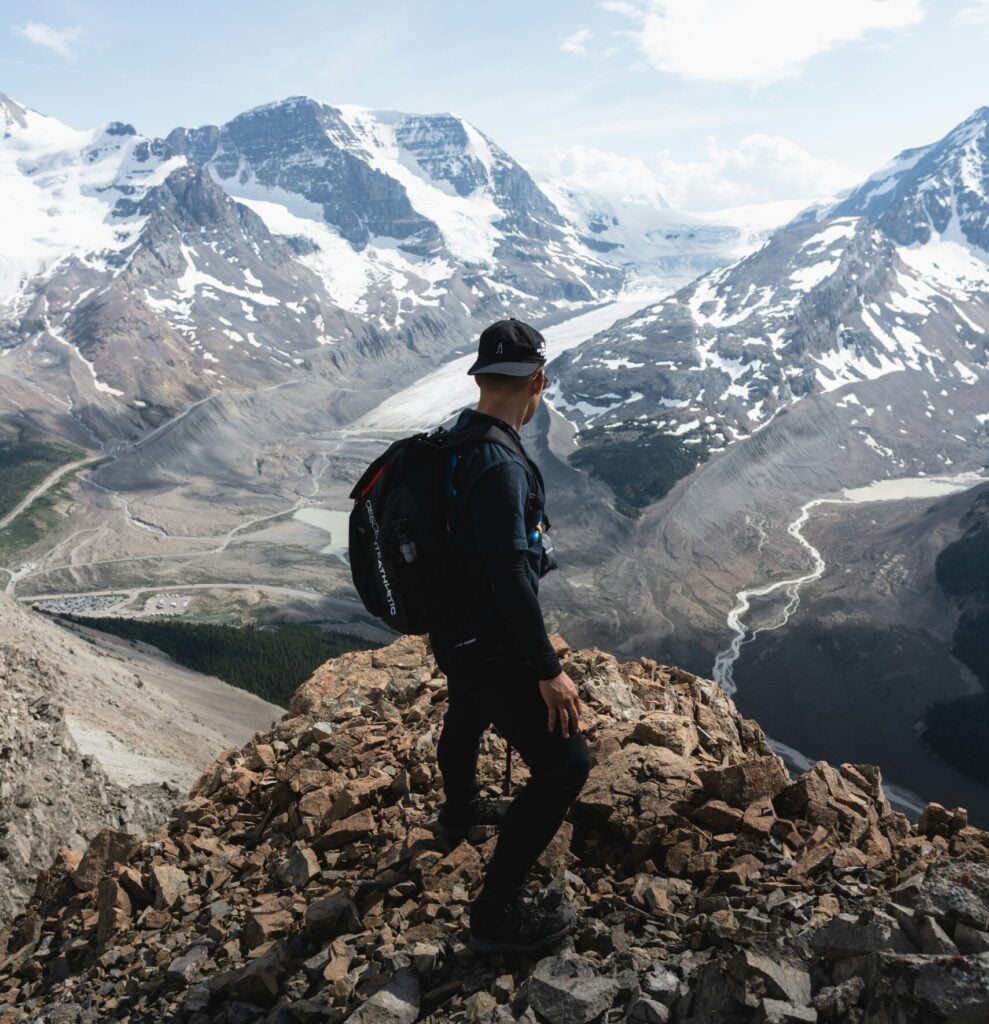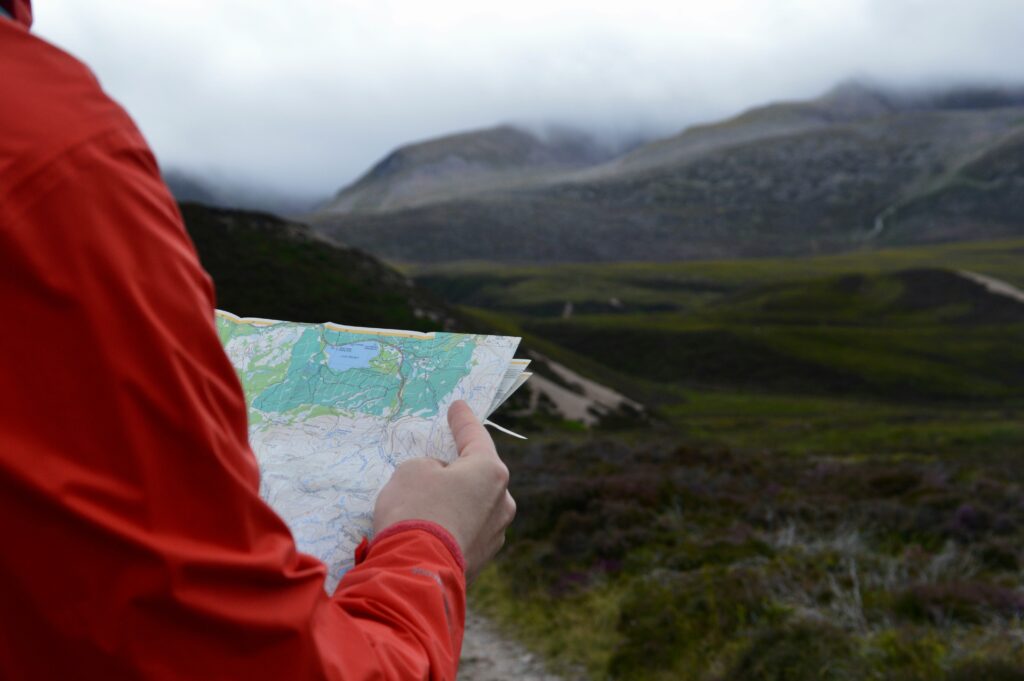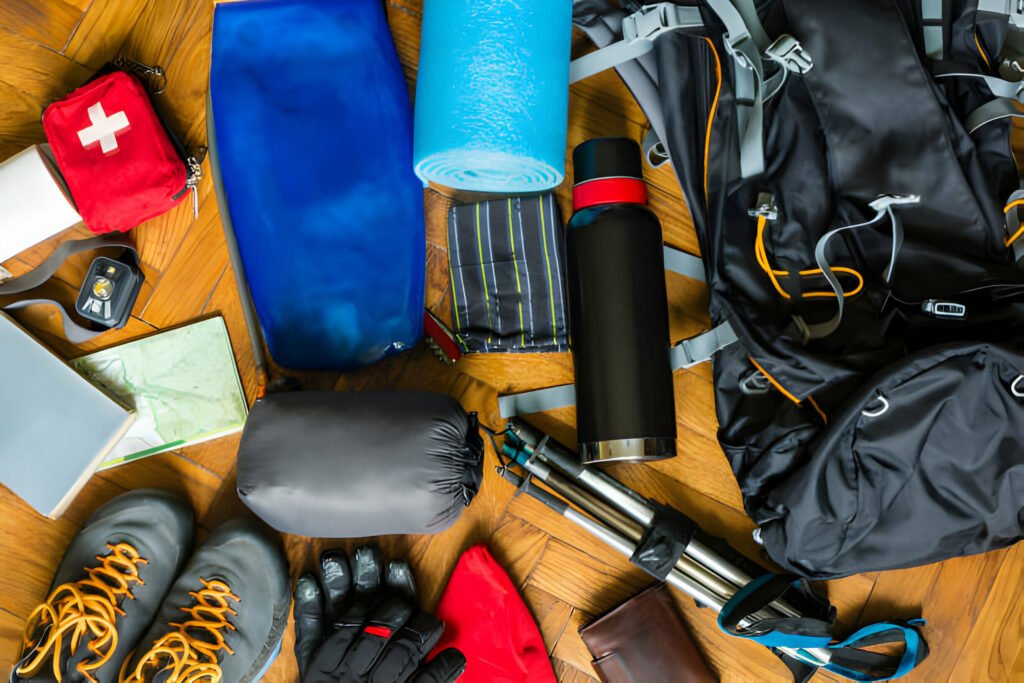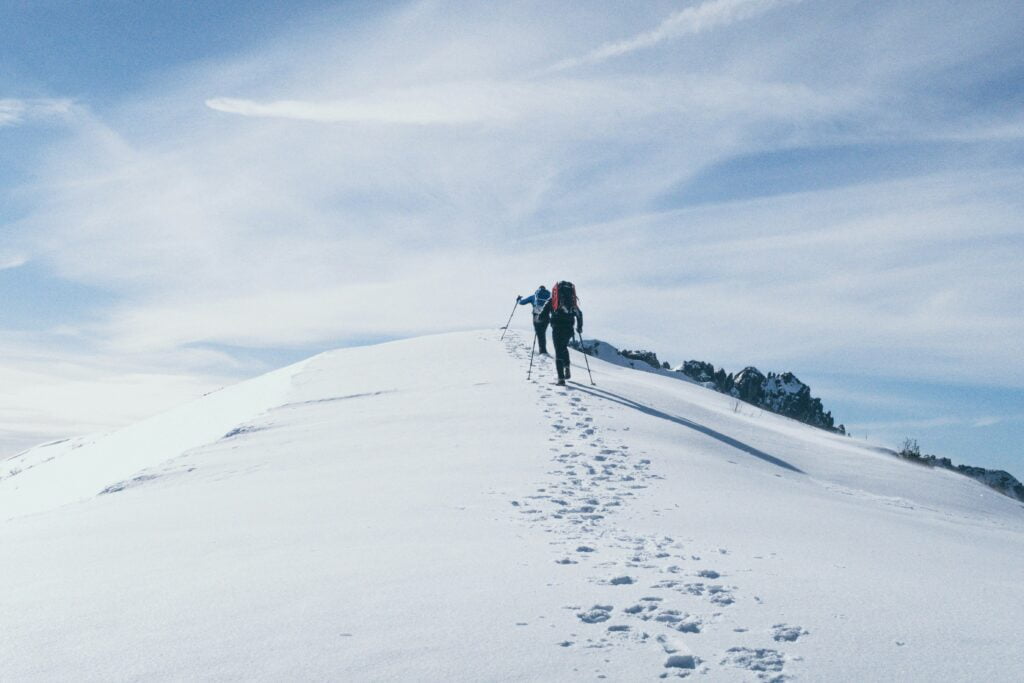Embarking on a trekking adventure can be an exhilarating experience for newcomers.
This comprehensive guide is designed to equip you with the essential knowledge and gear needed for a successful trekking journey.
From choosing the right equipment to exploring beginner-friendly trails and connecting with a like-minded community, here’s your roadmap to becoming a confident trekker.
1. Benefits of Trekking for Beginners

Trekking is not merely a physical activity; it’s a holistic journey that nurtures both the body and the mind.
For beginners, this outdoor pursuit offers a lot of benefits, fostering well-being in ways that extend far beyond the trail.
Let’s delve into the profound physical and mental advantages of trekking, encouraging newcomers to wholeheartedly embrace this invigorating activity.
Physical Benefits of Trekking:
- Cardiovascular Health Boost
Trekking involves sustained periods of moderate aerobic exercise, enhancing cardiovascular health. The heart pumps efficiently, improving blood circulation and overall heart function.
- Muscle Endurance and Strength
Ascending and descending varying terrains engages different muscle groups. This builds muscle endurance and strength, particularly in the legs, core, and back.
- Weight Management
Trekking is a calorie-burning activity that aids in weight management. The combination of aerobic exercise and varied terrain contributes to a healthy metabolism.
- Improved Respiratory Function
The fresh mountain air and steady breathing during trekking enhance respiratory function. This can lead to increased lung capacity and improved oxygen intake.
- Joint Flexibility
Negotiating uneven trails requires a range of motion, promoting joint flexibility. Trekking can contribute to better flexibility in the ankles, knees, and hips.
Mental Benefits of Trekking:
Nature has a profound calming effect. Trekking amidst natural landscapes reduces cortisol levels, alleviating stress and promoting mental tranquility.
- Enhanced Mood
Physical activity triggers the release of endorphins, often referred to as “feel-good” hormones. Trekking can elevate your mood, leaving you with a sense of euphoria and accomplishment.
- Mental Clarity and Focus
The meditative rhythm of trekking, combined with the sensory stimulation of nature, fosters mental clarity and focus. It provides an opportunity to unplug from daily stressors and immerse oneself in the present moment.
- Stress Resilience
Overcoming challenges on the trail cultivates resilience. This newfound resilience can extend to daily life, helping individuals cope with stressors more effectively.
- Connection with Nature
Trekking offers a profound connection with the natural world. This connection has been linked to improved mental well-being, reduced symptoms of anxiety and depression, and an overall sense of contentment.
2. Difficulty Levels of Hiking Trails for Beginners
Choosing the right hiking trail is similar to selecting the chapters of your outdoor adventure novel. Each trail offers a unique storyline, complete with challenges and rewards.
For beginners, understanding the difficulty levels of hiking trails is the compass to a gratifying trekking experience.
Let’s explore the nuances of these difficulty levels, empowering newcomers to embark on a trail that aligns with their skill level and aspirations.

Easy Trails –
Terrain:
- Well-maintained paths with minimal elevation gain.
- Generally suitable for all fitness levels.
Challenges:
- Mild ascents and descents.
- Few obstacles or technical elements.
Ideal For:
- Beginners with limited hiking experience.
- Families with children.
- Those seeking a leisurely nature walk.

Moderate Trails –
Terrain:
- Varied terrain with moderate elevation gain.
- May include uneven surfaces and occasional obstacles.
Challenges:
- Steeper ascents and descents.
- Moderate endurance is required.
Ideal For:
- Hikers looking for a moderate challenge.
- Those with some fitness and hiking experience.
- Adventurers seeking a balance of effort and reward.

Difficult Trails –
Terrain:
- Diverse and challenging terrain with significant elevation gain.
- Unpredictable surfaces and potential obstacles.
Challenges:
- Steep ascents and descents.
- Endurance and stamina are crucial.
Ideal For:
- Experienced hikers seeking a robust challenge.
- Those prepared for physically demanding treks.
- Enthusiasts aiming to push their limits.

Strenuous Trails –
Terrain:
- Demanding and rugged terrain with substantial elevation changes.
- May involve off-trail navigation and technical sections.
Challenges:
- Steep, sustained ascents and descents.
- Advanced endurance and physical fitness are required.
Ideal For:
- Seasoned hikers craving a formidable challenge.
- Fitness enthusiasts prepared for strenuous exertion.
- Individuals seeking an adrenaline-pumping adventure.
Choosing the Right Trail –
- Know Your Fitness Level:
- Be honest about your current fitness level to choose a trail that aligns with your capabilities.
- Start Gradually:
- For beginners, it’s advisable to begin with easy to moderate trails before progressing to more challenging routes.
- Research Trail Difficulty:
- Utilize trail guides and online resources to understand the difficulty level of your chosen trail.
- Consider Weather Conditions:
- Weather can impact trail difficulty. Factor in weather conditions when selecting a trail.
- Consult Experienced Hikers:
- Seek advice from experienced hikers or local outdoor communities for recommendations based on your skill level.
3. Beginner-Friendly Trekking Destinations
For those taking their first steps into the world of trekking, selecting the right destination is most important.
Each destination offers a unique blend of scenery, challenges, and cultural richness.
Let’s explore some of the best trekking destinations for beginners, providing options based on varying difficulty levels to ensure an enjoyable and rewarding experience.
1. Smoky Mountains National Park, USA (Easy to Moderate):
Highlights:
- Gentle trails are suitable for beginners.
- Rich biodiversity and stunning landscapes.
- Diverse wildlife, including black bears and elk.
Trail Options:
- Clingmans Dome Observation Tower Trail (Easy).
- Laurel Falls Trail (Moderate).
2. Lake District, England (Easy to Moderate):
Highlights:
- Idyllic lakes, rolling hills, and charming villages.
- Well-marked paths with various route options.
- Cultural and historical significance.
Trail Options:
- Cat Bells Walk (Easy).
- Helvellyn via Striding Edge (Moderate).
3. Cinque Terre, Italy (Easy to Moderate):
Highlights:
- Picturesque coastal trails overlooking the Mediterranean.
- Colorful villages perched on cliffs.
- Delicious Italian cuisine along the way.
Trail Options:
- Monterosso to Vernazza (Easy).
- Corniglia to Manarola (Moderate).
4. Annapurna Base Camp, Nepal (Moderate):
Highlights:
- Spectacular views of the Annapurna mountain range.
- Cultural encounters with local villages.
- Varied landscapes, from terraced fields to alpine meadows.
Trail Options:
- Poon Hill Trek (Moderate).
5. Camino de Santiago, Spain (Easy to Moderate):
Highlights:
- Historic pilgrimage route with cultural significance.
- Well-established trails and infrastructure.
- Scenic landscapes and charming villages.
Trail Options:
- French Way (Camino Francés) – Sarria to Santiago (Easy to Moderate).
6. Queen Charlotte Track, New Zealand (Easy to Moderate):
Highlights:
- Stunning coastal views in the Marlborough Sounds.
- Well-maintained trails are suitable for beginners.
- Native wildlife and diverse ecosystems.
Trail Options:
- Ship Cove to Anakiwa (Easy to Moderate).
7. Choosing Your Adventure: Tips for Beginners
- Consider Trail Length:
- Opt for trails with manageable distances for your fitness level.
- Check Elevation Gain:
- Begin with trails featuring minimal elevation gain, gradually progressing to more challenging terrain.
- Research Climate:
- Consider destinations with a climate conducive to comfortable trekking during your preferred travel time.
- Explore Guided Tours:
- Joining guided tours or trekking groups can enhance the experience and provide valuable support for beginners.
- Check Local Regulations:
- Be aware of any permits or regulations for the chosen destination.
By selecting a destination tailored to your comfort and experience level, you ensure a positive introduction to the world of trekking.
4. Introduction to map reading for Trekking

In the realm of trekking, where the path less traveled often leads to the most rewarding adventures, map reading stands as a fundamental skill.
Far beyond a paper with lines and symbols, a map is a trekkers’ compass, revealing the topography of the land and guiding them through the uncharted.
Let’s delve into the intricacies of map reading, unlocking the secrets that transform a seemingly complex map into a very important tool for navigating unfamiliar terrain.
Understanding Map Components
- Scale:
- The scale indicates the ratio of distance on the map to the corresponding distance on the ground. Understanding scale is crucial for estimating distances and planning trekking routes accurately.
- Legend (Key):
- The legend decodes the symbols used on the map. Each symbol represents a feature like rivers, trails, elevation contours, and more. Mastery of the legend is key to interpreting the map’s details.
- Contour Lines:
- Contour lines depict the elevation changes in the terrain. Close contour lines signify steep slopes, while widely spaced lines indicate flatter areas. By recognizing these lines, trekkers can visualize the landscape’s ruggedness.
- Grid Coordinates:
- Maps are often divided into a grid system, usually using latitude and longitude or a Universal Transverse Mercator (UTM) grid. This helps in pinpointing locations with precision.
Map Orientation: Finding Your True North
- Compass Use:
- A compass aids in aligning the map with the actual terrain. Ensure the map’s top aligns with the compass needle, providing an accurate representation of your surroundings.
- Identifying Landmarks:
- Locate prominent features on the map, such as mountain peaks, rivers, or distinctive bends in a trail. Aligning these features with the actual landscape confirms your orientation.
Route Planning: Crafting Your Trail Tale
- Trail Selection:
- Evaluate available trails on the map, considering their difficulty, length, and potential challenges. Choose a route that aligns with your trekking goals and skill level.
- Contour Navigation:
- Use contour lines to anticipate the terrain’s steepness and identify potential obstacles. This skill aids in planning efficient and safe routes.
On-Trail Navigation: Real-Time Application
- Constant Referencing:
- Regularly cross-reference the map with your surroundings as you trek. This ensures you stay on the planned route and helps build a mental map of the terrain.
- Pacing and Timing:
- Estimate your travel time based on the map’s scale and your planned route. Pacing and timing help in anticipating landmarks and confirming your progress.
Advanced Techniques
- Terrain Association:
- Connect features on the map with the actual terrain by recognizing landforms, vegetation patterns, and other distinctive elements.
- GPS Integration:
- While traditional map reading is foundational, integrating GPS technology can enhance accuracy and provide real-time location confirmation.
Practical Tips for Beginners:
- Practice in Familiar Terrain:
- Begin honing map reading skills in familiar areas before venturing into the unknown.
- Take a Map Reading Course:
- Consider joining a map reading or orienteering course to receive hands-on guidance.
- Use Topographic Maps:
- Topographic maps provide detailed elevation information, aiding in better terrain visualization.
- Stay Updated:
- Regularly update your maps to ensure accuracy, especially for trails and features that may change over time.
Map reading is a journey in itself, evolving with each trail and terrain encountered. As trekkers master this skill, the once-daunting map transforms into a trusted companion, opening up a world of exploration in even the most unfamiliar landscapes. So, unfurl that map, trace your route, and let the adventure unfold with each contour and landmark.
5. Essential Trekking Gear

For Beginners, these are the necessary gear and a comprehensive checklist to ensure you’re well-prepared for your trekking journey.
- Trekking Boots
Invest in a pair of quality trekking boots that offer ankle support and traction. These boots are your foundation, ensuring stability on uneven terrains and safeguarding your feet from the rigors of the trail.
- Weatherproof Clothing
Pack weatherproof clothing that adapts to varying conditions. A waterproof and breathable jacket, moisture-wicking base layers, and convertible pants are essential. Layering allows you to adjust to temperature changes, keeping you comfortable throughout your trek.
- Backpack
Select a backpack with the right capacity for your trek’s duration. Look for one with adjustable straps for a personalized fit. Ensure it’s equipped with compartments to organize gear efficiently and don’t forget a rain cover to shield your belongings from unexpected downpours.
- Navigation Tools
Familiarize yourself with basic navigation tools. Carry a detailed map of your trail, and a reliable compass, and consider a GPS device for added precision. These tools are your navigational companions, ensuring you stay on the right path.
- Trekking Poles
Trekking poles provide stability on uneven terrain and reduce the strain on your knees. Opt for adjustable and lightweight poles that can be customized to your height and the demands of the trail.
- Illumination
A reliable headlamp or flashlight is crucial for trekking, especially during early-morning starts or late-night camp setups. Ensure it’s lightweight, and has a long battery life, and consider bringing spare batteries.
- Hydration System
Stay hydrated with a portable water system. Options include water bottles or a hydration reservoir with a tube for easy access. Ensure you have enough capacity to last between water sources on your chosen trail.
- First Aid Kit
Pack a compact first aid kit containing essentials like adhesive bandages, pain relievers, antiseptic wipes, and any personal medications. Customize it based on your specific needs and any medical conditions.
- Nutrition
Carry high-energy snacks and meals suitable for trekking. Opt for lightweight, non-perishable items such as energy bars, trail mixes, and dehydrated meals. Ensure you have enough to sustain your energy throughout the trek.
- Shelter
Depending on your trek’s nature, consider carrying a lightweight and compact shelter option such as a tent or a bivy. Ensure it suits the expected weather conditions and provides a comfortable space for rest.
6. Trekking in different seasons

Trekking is a dynamic pursuit, and the changing seasons bring forth a spectrum of experiences, challenges, and breathtaking landscapes.
For beginners venturing into the world of trekking, understanding the nuances of each season is essential.
Let’s embark on a journey through the seasons, guiding newcomers on what to expect and how to prepare for the diverse conditions nature unfolds.
1. Spring: The Reawakening of Nature
Key Characteristics:
- Blooming wildflowers, vibrant foliage, and thawing landscapes.
- Mild temperatures and longer daylight hours.
- Potential for muddy trails due to melting snow and rainfall.
What to Expect:
- Enjoy the blossoming beauty of nature.
- Be prepared for varying trail conditions, including wet and muddy sections.
- Mild temperatures require layering for comfort during temperature fluctuations.
Tips for Beginners:
- Pack rain gear and waterproof footwear.
- Embrace the burst of colors with a camera or smartphone for nature photography.
2. Summer: Endless Days of Trekking Bliss
Key Characteristics:
- Warm temperatures and extended daylight.
- Abundant greenery and clear mountain vistas.
- Crowded trails, especially in popular trekking destinations.
What to Expect:
- Longer trekking days with ample daylight.
- Diverse flora and fauna at their peak.
- Increased fellow trekkers on well-known trails.
Tips for Beginners:
- Hydrate adequately and carry sufficient water.
- Use sunscreen and wear breathable clothing to stay cool.
- Plan and start early to avoid the afternoon heat.
3. Autumn: Nature’s Colorful Palette
Key Characteristics:
- Foliage transitions to vibrant hues of red, orange, and gold.
- Cooler temperatures and crisp, clear air.
- Quieter trails compared to the summer season.
What to Expect:
- Stunning autumnal landscapes.
- Cooler temperatures require layering for warmth.
- Possible early snowfall at higher elevations.
Tips for Beginners:
- Dress in layers to adapt to temperature changes.
- Capture the picturesque scenery with a camera or sketchbook.
4. Winter: A Silent Trekking Wonderland
Key Characteristics:
- Snow-covered landscapes and icy trails.
- Cold temperatures and shorter daylight hours.
- Serenity and tranquility as fewer trekkers venture out.
What to Expect:
- Pristine, snow-laden scenery.
- Specialized gear is required for snowy and icy conditions.
- Limited trail accessibility in some regions.
Tips for Beginners:
- Invest in insulated and waterproof winter gear.
- Learn basic snow trekking techniques and use traction devices for icy trails.
- Plan shorter treks to acclimatize to cold conditions.
General Tips for Trekking Through Seasons:
- Check Weather Forecasts:
- Stay updated on weather conditions before your trek.
- Adjust Clothing Layers:
- Dress in layers to accommodate temperature changes.
- Consider Trail Conditions:
- Be prepared for varying trail conditions such as mud, snow, or ice.
- Plan Accordingly:
- Adjust trekking plans based on the season and local conditions.
- Safety First:
- Prioritize safety and be aware of seasonal challenges such as slippery trails or extreme temperatures.
By understanding the nuances of trekking in different seasons, beginners can tailor their preparations and expectations, ensuring a more enjoyable and rewarding experience on the trail.
Each season offers its unique charm, and with proper preparation, you’ll find joy in every step of your trekking journey.
7. Online Trekking Communities

Embarking on a trekking adventure is not just about traversing landscapes; it’s also about building connections with like-minded individuals who share a passion for exploration.
Online trekking communities and forums provide a virtual haven for adventurers to share experiences, seek advice, and gain insights from the collective wisdom of the trekking community.
Let’s explore some vibrant platforms where trekkers can connect, inspire, and learn together.
1. Reddit – r/hiking and r/backpacking:
Features:
- A diverse community with a global reach.
- Subreddits dedicated to hiking and backpacking discussions.
- Users share trip reports, and gear reviews, and seek advice.
Why Join:
- Engage with a vast community of trekkers.
- Access firsthand experiences and recommendations.
- Participate in discussions on gear, trails, and tips.
2. Trek Earth:
Features:
- Community-centered around travel and trekking photography.
- Users share their trekking adventures through captivating images.
- Forums for travel-related discussions and advice.
Why Join:
- Explore the world through the lens of fellow trekkers.
- Connect with photography enthusiasts and share your visual tales.
- Seek advice on destinations and photography techniques.
3. AllTrails Community:
Features:
- Integrated community within the AllTrails app.
- Users share trail reviews, photos, and tips.
- Access to a vast database of trails worldwide.
Why Join:
- Plan your treks with insights from a community of fellow hikers.
- Share your trail experiences and contribute to a comprehensive trail database.
- Connect with local hikers and explore new trails.
4. Backpacking Light Forums:
Features:
- Focus on lightweight and ultralight backpacking.
- Discussions on gear, techniques, and trip reports.
- Community of backpackers emphasizing minimalistic approaches.
Why Join:
- Gain insights into lightweight backpacking strategies.
- Discuss and learn about cutting-edge gear.
- Connect with a community focused on efficient and enjoyable trekking.
5. Trail Journals:
Features:
- A platform for creating and sharing digital trail journals.
- Users document their trekking experiences through narratives and photos.
- Connect with other trekkers through shared journal entries.
Why Join:
- Tell your trekking story through a personalized digital journal.
- Read and learn from the experiences of fellow trekkers.
- Connect with individuals who have tackled similar trails.
6. Outdoor Gear Lab Community:
Features:
- Extension of the popular gear review website.
- Community discussions on outdoor gear and equipment.
- Access to expert reviews and user insights.
Why Join:
- Get in-depth insights into outdoor gear.
- Discuss and share your experiences with different equipment.
- Connect with a community focused on gear quality and performance.
7. Benefits of Joining Online Trekking Communities:
- Shared Knowledge:
- Learn from the experiences of seasoned trekkers.
- Gain insights into specific trails, gear, and techniques.
- Community Support:
- Connect with like-minded individuals who share your passion.
- Seek advice, share concerns, and celebrate achievements with the community.
- Trail Recommendations:
- Discover new trails and destinations recommended by fellow trekkers.
- Receive firsthand information on trail conditions and challenges.
- Gear Reviews and Recommendations:
- Stay informed about the latest outdoor gear trends.
- Share your experiences with equipment and contribute to a collective knowledge base.
- Inspiration and Motivation:
- Draw inspiration from the adventures of others.
- Motivate and be motivated by sharing your trekking stories.
Joining these online trekking communities is not just about information; it’s about fostering a sense of camaraderie with fellow adventurers who understand the thrill of the trail.
So, dive into the digital trekking realm, connect with the community, and let the collective spirit of exploration propel your trekking journey forward.
What is trekking vs hiking?
Trekking and hiking both involve walking in natural settings, but trekking often implies longer journeys, sometimes across multiple days and challenging terrains. Hiking is a more general term for walking in nature, often on well-established trails.
What do you mean by trekking?
Trekking refers to a multi-day journey through challenging terrains, typically in remote or mountainous regions. It involves a combination of hiking and camping, emphasizing endurance and exploration.
What does go trekking mean?
“Go trekking” encourages embarking on a challenging, adventurous journey, often through diverse landscapes, to explore nature’s beauty and push personal boundaries.
Is it trekking or tracking?
It is “trekking.” “Tracking” usually refers to monitoring or following the movements of something, whereas “trekking” specifically relates to long-distance hiking expeditions.






Leave a Comment